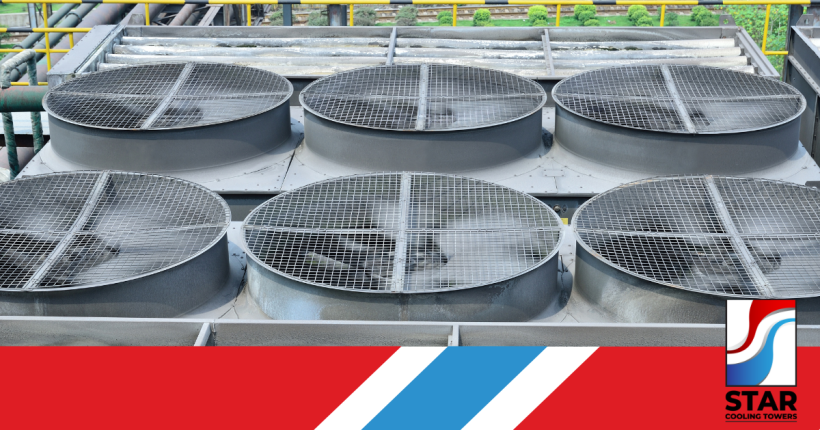Cooling towers play a critical role in maintaining the temperature of industrial and commercial operations. But understanding the different types of cooling towers, their functions, and their benefits can be confusing. In this post, we’ll explore the intricacies of open loop and closed loop cooling towers to help building managers and industrial operators make informed decisions.
Introduction to Cooling Towers
Cooling towers are essential for removing excess heat from buildings and industrial processes. They transfer heat from water to the air, cooling machinery and environments efficiently. This heat-transfer process is vital in industries like manufacturing, energy production, and HVAC systems. Without effective cooling systems, equipment could overheat, leading to costly repairs and downtime.
Cooling towers come in various designs but generally consist of a recirculating pump, fill media or wet deck fill, and heat exchanger components. These elements work together to cool water, which is then recycled back into the system. This allows for efficient temperature control and resource management.
In this article, we’ll break down the differences between open loop and closed loop cooling towers, highlight their benefits, and offer maintenance tips to keep your cooling systems running smoothly.
Understanding Open Loop Cooling Towers
How a Open Loop Cooling Tower Operates
Open loop cooling towers, also known as open circuit cooling towers, cool water by directly exposing it to the air. Here’s how they work:
- Water Circulation: Water is pumped from the system into the cooling tower.
- Heat Transfer Efficiency: The water flows vertically over fill media, increasing its surface area and enhancing heat load transfer.
- Evaporative Cooling: A small portion of water evaporates, carrying heat away and cooling the remaining water.
- Recirculation: The cooled water is collected at the bottom and returned to the system.
Advantages of Open Loop Cooling Towers
Open loop cooling towers offer several benefits:
- Efficiency: Direct contact with air allows for effective heat transfer.
- Cost-Effectiveness: Generally less expensive to install and maintain compared to closed loop systems.
- Versatility: Suitable for various applications, including HVAC, power plants, and manufacturing.
Industries Using Open Loop Cooling Towers
Open loop cooling towers are commonly used in:
- Power Plants: To cool condenser water.
- HVAC Systems: For large commercial buildings.
- Manufacturing: In processes requiring efficient heat removal.
Understanding Closed Loop Cooling Towers
How Closed Loop Cooling Towers Operate
Closed circuit cooling towers, or closed loop system, use a sealed system to cool water. Here’s a breakdown of their operation:
- Heat Transfer Fluid: A heat transfer media (usually water or glycol) circulates through a closed loop.
- Heat Exchange: A closed loop cooling system maintains the optimal temperature within a sealed enclosure while keeping out warmer ambient air, humidity, dust, and other airborne contaminants.
- Evaporative cooling towers: Water sprayed onto the heat exchanger evaporates, removing heat from the system.
- Recirculation: The cooling system is recirculated within the closed loop.
Benefits of Closed Loop Cooling Towers
Closed loop cooling towers offer distinct advantages:
- Contamination Prevention: The sealed system prevents contaminants from entering the cooling water.
- Efficiency: Reduced risk of scaling and fouling, maintaining efficient heat transfer.
- Longevity: Less wear and tear on equipment due to cleaner water circulation.
Industries Preferring Closed Loop Cooling Towers
Closed loop cooling towers are preferred in:
- Data Centers: Where clean cooling water is essential.
- Pharmaceutical Manufacturing: To avoid contamination in sensitive processes.
- Food and Beverage Processing: To maintain high hygiene standards.
Comparing the Two Systems
Efficiency
When comparing efficiency, both systems have their strengths:
- Open Loop: Direct contact with air flow allows for rapid heat transfer, making them highly efficient in suitable climates.
- Closed Loop: Although slightly less efficient due to the additional heat exchanger, closed loop systems maintain efficiency by preventing contamination and scaling.
Environmental Impact
Considering the environmental impact is crucial:
- Open Loop: Higher water consumption and potential for chemical treatments can impact the environment.
- Closed Loop: More environmentally friendly due to reduced water usage and minimal chemical requirements.
Cost Considerations
Cost is a significant factor for building managers:
- Open Loop: Lower initial installation costs but may require higher maintenance due to contamination and scaling.
- Closed Loop: Higher upfront costs but lower long-term maintenance expenses due to cleaner water circulation.
Best Practices for Cooling Tower Maintenance
Regular Inspections
Conduct regular inspections to ensure optimal performance:
- Visual Checks: Look for signs of wear, corrosion, or leaks.
- Performance Monitoring: Track temperature and flow rates to detect any anomalies.
- Water Quality Testing: Regularly test water for contaminants and chemical balance.
Cleaning and Servicing
Maintain cleanliness to prevent scaling and fouling:
- Routine Cleaning: Clean fill media, nozzles, and heat exchangers to remove debris and scale.
- Chemical Treatment: Use appropriate chemicals to control algae, bacteria, and scale buildup.
- Professional Servicing: Schedule regular professional servicing to address any issues promptly.
Operational Adjustments
Make operational adjustments for efficiency:
- Seasonal Adjustments: Modify settings based on seasonal temperature changes.
- Load Management: Adjust cooling capacity based on system load to optimize performance.
- Energy Efficiency: Implement energy-efficient practices to reduce operational costs.
Conclusion
In summary, understanding the differences between open loop and closed loop cooling towers is essential for building managers and industrial operators. Open loop systems offer cost-effective and versatile solutions, while closed loop systems provide contamination prevention and longevity. By following best practices for maintenance, you can ensure the optimal performance and efficiency of your cooling towers.
Explore further resources or contact our experts to learn more about how these systems can benefit your operations. Your cooling tower’s efficiency and reliability can make all the difference in maintaining a productive and cost-effective environment.


